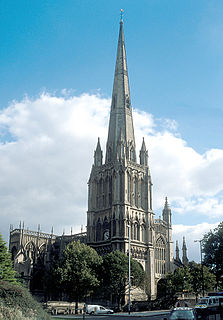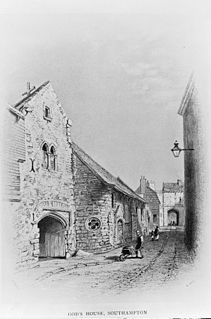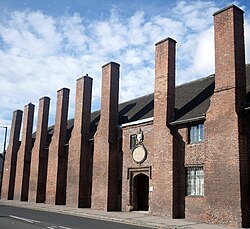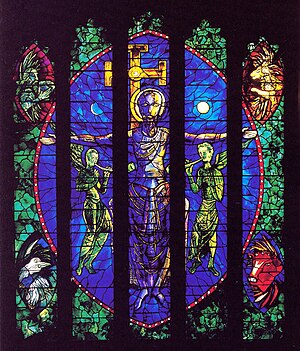
Sherborne Abbey, otherwise the Abbey Church of St. Mary the Virgin, is a Church of England church in Sherborne in the English county of Dorset. It has been a Saxon cathedral (705–1075), a Benedictine abbey church (998–1539), and since 1539, a parish church.

Sir George Gilbert Scott, known as Sir Gilbert Scott, was a prolific English Gothic Revival architect, chiefly associated with the design, building and renovation of churches and cathedrals, although he started his career as a leading designer of workhouses. Over 800 buildings were designed or altered by him.

Lichfield is a cathedral city and civil parish in Staffordshire, England. Lichfield is situated roughly 18 miles (29 km) south-east of the county town of Stafford, 8.1 miles (13.0 km) south-east of Rugeley, 9 miles (14 km) north-east of Walsall, 7.9 miles (12.7 km) north-west of Tamworth and 13 miles (21 km) south-west of Burton Upon Trent. At the time of the 2011 Census, the population was estimated at 32,219 and the wider Lichfield District at 100,700.

Lichfield Cathedral in Lichfield, Staffordshire, England, is the only medieval English cathedral with three spires. The Anglican Diocese of Lichfield covers Staffordshire, much of Shropshire, and parts of the Black Country and West Midlands. The current Bishop of Lichfield, Michael Ipgrave, was appointed in 2016. It is a Grade I listed building.

Rochester Cathedral, formally the Cathedral Church of Christ and the Blessed Virgin Mary, is an English church of Norman architecture in Rochester, Kent.

Lichfield is a local government district in Staffordshire, England. It is administered by Lichfield District Council, based in Lichfield.

William Smyth was Bishop of Coventry and Lichfield from 1493 to 1496 and then Bishop of Lincoln until his death. He held political offices, the most important being Lord President of the Council of Wales and the Marches. He became very wealthy and was a benefactor of a number of institutions. He was a co-founder of Brasenose College, Oxford and endowed a grammar school in the village of his birth in Lancashire.
King Edward VI School, Lichfield, is a co-educational comprehensive school near the heart of the city of Lichfield, Staffordshire, England. The school is a co-educational comprehensive school maintained by Staffordshire Education Authority and admits pupils from the age of 11, with most electing to continue their education into the Sixth Form, leaving at 18. In the main school, the published admissions number is 214 pupils for each year group. In total there are in excess of 1400 pupils on roll.

The Hospital of St Cross and Almshouse of Noble Poverty is a medieval almshouse in Winchester, Hampshire, England. It has been described as "England's oldest and most perfect almshouse". Most of the buildings and grounds are open to the public at certain times. It is a Grade I listed building.

There are 100 Grade I listed buildings in Bristol, England according to Bristol City Council. The register includes many structures which for convenience are grouped together in the list below.

St Mark's Church is an ancient church on the north-east side of College Green, Bristol, England, built c. 1230. Better known to mediaeval and Tudor historians as the Gaunt's Chapel, it has also been known within Bristol since 1722 as the Lord Mayor's Chapel. It is one of only two churches in England privately owned and used for worship by a city corporation. The other is St Lawrence Jewry, London. It stands opposite St Augustine's Abbey, founded by a member of the Berkeley family of nearby Berkeley Castle, from which it was originally separated by the Abbey's burial ground, now called College Green. It was built as the chapel to the adjacent Gaunt's Hospital, now demolished, founded in 1220. Except for the west front, the church has been enclosed by later adjacent buildings, although the tower is still visible. The church contains some fine late gothic features and a collection of continental stained glass. It is designated by Historic England as a grade I listed building.

English Gothic is an architectural style that flourished from the late 12th until the mid-17th century. The style was most prominently used in the construction of cathedrals and churches. Gothic architecture's defining features are pointed arches, rib vaults, buttresses, and extensive use of stained glass. Combined, these features allowed the creation of buildings of unprecedented height and grandeur, filled with light from large stained glass windows. Important examples include Westminster Abbey, Canterbury Cathedral and Salisbury Cathedral. The Gothic style endured in England much longer than in Continental Europe.

St John the Baptist's Church is the former cathedral of Chester, Cheshire, England during the Early Middle Ages. The church, which was first founded in the late 7th Century by the Anglo Saxons, is outside Chester's city walls on a cliff above the north bank of the River Dee. It is now considered to be the best example of 11th–12th century church architecture in Cheshire, and was once the seat of the Bishop of Lichfield from 1075 to 1095.
St John's Foundation was founded as St John's Hospital in Bath, Somerset, England, in 1174, by Bishop Reginald Fitz Jocelin and is among the oldest almshouses in England. The current building was erected in 1716 and has been designated as a Grade I listed building.

St Mary's Church is a city centre church in Lichfield, Staffordshire in the United Kingdom, located on the south side of the market square. A church is reputed to have been on the present site since at least 1150 but the current building dates from 1870 and is a Grade II* listed building. The church was remodelled in the early 1980s and again in 1997-1999 and now serves a variety of purposes including Lichfield Library and Tourist Information on the ground floor, and on the top floor, The Hub at St Mary's is now home to a speciality coffee shop, art gallery, treasury exhibition and performing arts space.

The Bishop's Palace is a 17th-century building situated in the north-east corner of the Cathedral Close in Lichfield, Staffordshire in England.

The Church of St Michael and All Angels is a parish church and Grade I listed building in the village of Hamstall Ridware, Staffordshire. The church is situated in a remote position to the north of the village accessed by a 250 m (820 ft) pathway through pasture land. The church is situated on a gentle slope 160 m (520 ft) west of the River Blithe. The church was founded in 1130—1150 but the majority of the present church was built of ashlar sandstone in the 14th and 15th centuries.
This is a list of scheduled monuments and listed buildings in the English city of Exeter, Devon.

God's House Hospital, also known as the Hospital of St. Julian or Domus Dei is a refuge for poor travellers in Southampton, England. Much of the complex has now been destroyed, with only four buildings remaining: the gatehouse, God's House Tower, a grade I listed scheduled ancient monument; and the chapel, St. Julien's Church, a grade I listed building; and two accommodation blocks dating from the 19th century.

The Church of St Mary the Virgin in Pilton is the 13th-century Anglican parish church for the Pilton suburb of Barnstaple in Devon. It has been a Grade I listed building since 1951 and comes under the Diocese of Exeter.





















